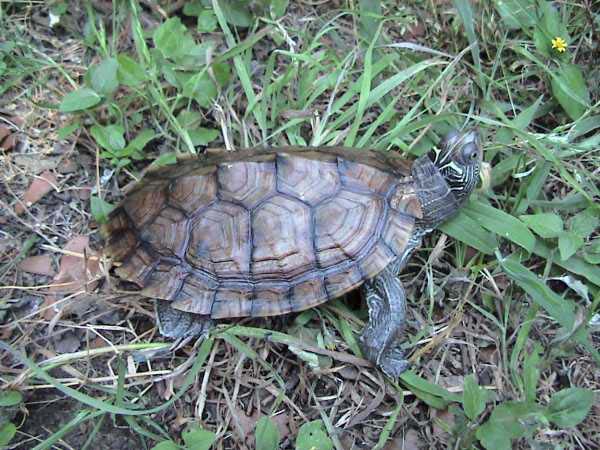Wildlife North America . com North American Animals - mamals, birds, reptiles, insects |
False Map Turtle (Graptemys pseudogeographica)
False Map Turtle Photograph by LA Dawson. Some rights reserved. (view image details)
FALSE MAP TURTLE FACTS
DescriptionThe False Map Turtle carapace is olive, brown, or black with dark blotches surrounded by yellow lines. The lines can form a fine web pattern over the shell. The markings are more prominent on young turtles. The carapace has serrated edges and a keel along the spine. The underside (plastron) is cream or yellow colored. Young turtles have patterned plastron. The skin is olive to brown with yellow lines on the legs, tail, chin, and neck. The head is broad and may have an l-shaped marking behind the eyes. Adult males have a longer tail than females. Size length: males 9cm -15cm; females 12cm - 27cm Environment False map turtles are found mainly in large rivers and backwaters, also found in lakes, ponds, marshes. They prefer slow moving water with places to bask, and plenty aquatic vegetation. Food mollusks, insects and insect larvae, fish carrion, and some vegetation. Breeding Nests from mid-May to late July. The nest is dug during the day from 5 to 150 m from water in open sandy areas or areas with low shrubs. The female digs a 10cm to 16 cm deep nest and lays 8-22 eggs. After laying, she covers them sand. Females lay 2 to 3 clutches in a year. Range The False Map Turtles is found in Mississippi and Missouri River basins from Louisiana and Texas in the south to Minnesota and South Dakota in the north and east to Ohio Classification
Relatives in same Genus Barbour's Map Turtle (G. barbouri) Common Map Turtle (G. geographica) Mississippi Map Turtle (G. kohnii) Black knobbed Map Turtle (G. nigrinoda) Alabama Map Turtle (G. pulchra) Home | Mammals | Reptiles | Birds | Insects | Privacy Policy | Disclaimer | Contact Us |